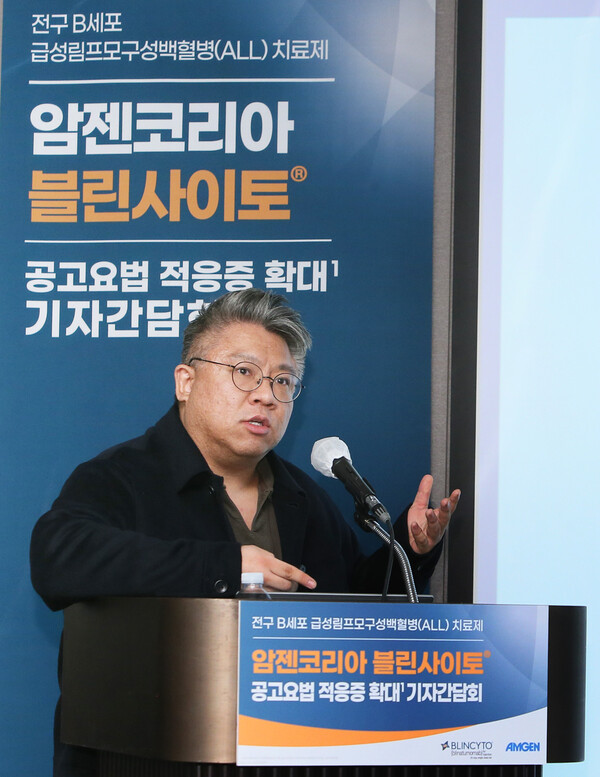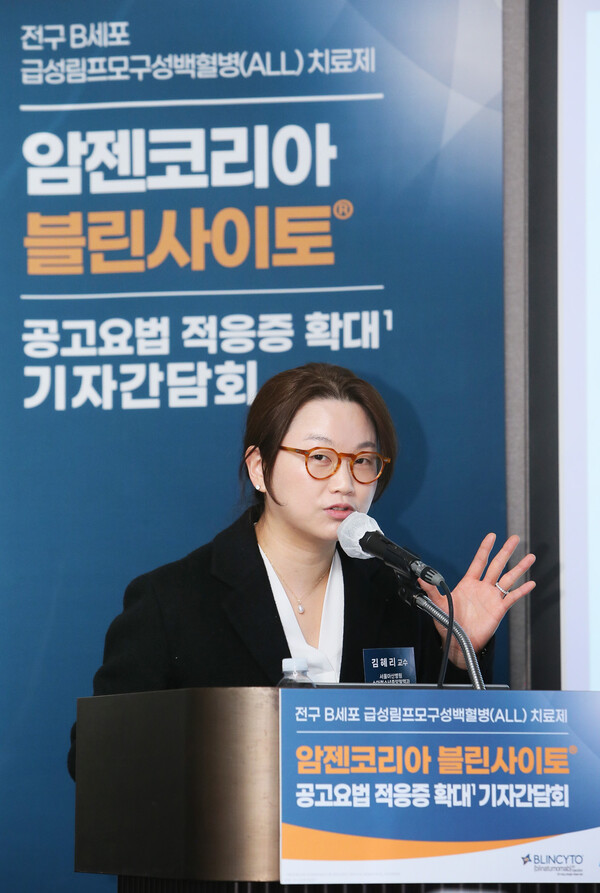Amgen’s Blincyto (ingredient: blinatumomab) has significantly expanded its role in the treatment of acute lymphoblastic leukemia (ALL) with approval for use as consolidation therapy.
Consolidation therapy eliminates leukemia cells after induction therapy for remission.
This marks a shift in the treatment paradigm, potentially reducing the need for hematopoietic stem cell transplantation (HSCT) in certain patients.
On Feb. 14, Korea’s Ministry of Food and Drug Safety (MFDS) approved Blincyto as a consolidation therapy for patients with Philadelphia chromosome-negative (Ph-) precursor B-cell ALL. The expansion builds upon its previous approvals for relapsed or refractory B-cell precursor ALL in 2015 and minimal residual disease (MRD)-positive B-cell precursor ALL in 2020.
The new approval allows adult and pediatric Ph- precursor B-cell ALL patients to receive up to four cycles of Blincyto consolidation therapy. This represents a significant advancement, as previously, consolidation therapy options were limited to chemotherapy and HSCT.
Amgen held a press conference on Wednesday on the expanded indication of Blincyto for consolidation therapy in precursor B-cell acute lymphoblastic leukemia and highlighted its future role.
Traditionally, ALL treatment consists of three phases -- induction therapy to achieve remission, consolidation therapy to eliminate residual leukemia cells, and maintenance therapy to prevent relapse. For many ALL patients, HSCT has been a critical component of consolidation therapy. However, HSCT is associated with severe complications, including graft-versus-host disease, and is not a viable option for all patients due to donor availability or pre-existing conditions.

Professor Yoon Jae-ho at Seoul St. Mary’s Hospital explains the significance of Blincyto’s expansion in treating acute lymphoblastic leukemia at Josun Palace Seoul on Wednesday. (Credit: Amgen Korea)
“Until now, first-line treatment for precursor B-cell ALL relied primarily on chemotherapy and stem cell transplantation,” Professor Yoon Jae-ho of the Department of Hematology at Seoul St. Mary’s Hospital said. “The approval of Blincyto provides a new treatment option that reduces relapse risk and improves survival.”
Blincyto’s approval was based on strong clinical evidence, including results from the E1910 trial.
This study examined MRD-negative adult precursor B-cell ALL patients receiving either Blincyto plus chemotherapy or chemotherapy alone as consolidation therapy. Among 112 patients treated with Blincyto and chemotherapy, the three-year overall survival (OS) rate was 85 percent, compared to 68 percent in the chemotherapy-only group. Additionally, the three-year relapse-free survival (RFS) rate was 80 percent in the Blincyto group versus 64 percent in the chemotherapy-only group.
“These findings suggest that Blincyto not only improves survival outcomes but could also reduce the reliance on HSCT in some patients,” Yoon emphasized.
During the conference, a pediatric oncologist also expressed an optimistic view about Blincyto’s role in childhood ALL.

Professor Kim Hye-ry of the Department of Pediatric Hematology & Oncology at Asan Medical Center speaks at the conference. (Credit: Amgen Korea)
Professor Kim Hye-ry of the Department of Pediatric Hematology & Oncology at Asan Medical Center highlighted findings from the AALL1731 study, which involved 1,140 pediatric precursor B-cell ALL patients with standard or high relapse risk.
The study found that the three-year disease-free survival (DFS) rate was 96 percent in the Blincyto-chemotherapy group, significantly higher than the 87.9 percent observed in the chemotherapy-only group.
“For over two decades, pediatric ALL treatment has relied solely on chemotherapy. The introduction of Blincyto as a consolidation therapy offers a new approach that brings children closer to a cure,” Kim said.
Additionally, the AALL1331 trial showed that among pediatric ALL patients aged 1–30, those receiving Blincyto had a four-year DFS rate of 61.2 percent compared to 49.5 percent in the chemotherapy group. Though statistical significance was not reached, the trend suggests meaningful clinical benefits.
“Pediatric patients generally tolerate treatment well and have higher remission rates than adults,” Kim said. “Blincyto has demonstrated its ability to increase survival rates and improve transplant eligibility by helping more patients achieve complete remission.”
Kim further emphasized the need for reimbursement for Blincyto in pediatric ALL cases, referencing the AALL1731 study as a basis for this request.
“Both international and Korean medical societies apply the same treatment protocols for all pediatric ALL patients,” she said. “It is crucial that reimbursement policies reflect this and allow for rapid access to Blincyto for both MRD-positive and MRD-negative patients upon diagnosis.”